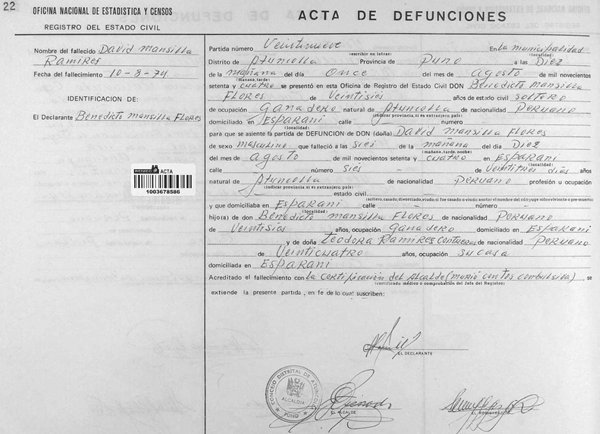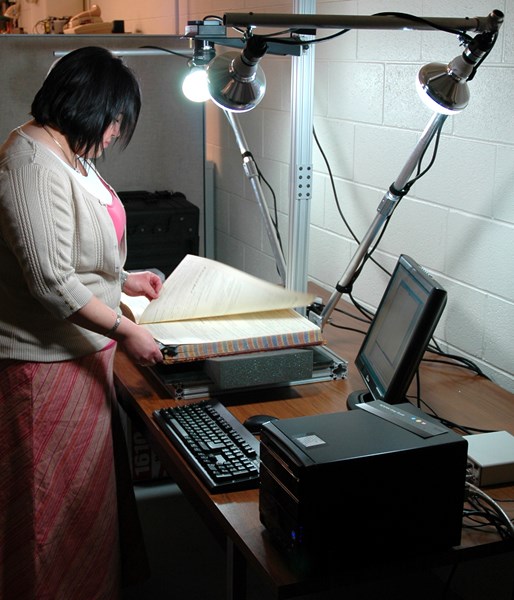SALT LAKE CITY, UTAH, June 23, 2014 (GLOBE NEWSWIRE) -- FamilySearch International (FamilySearch.org) announced today the online publication of its one billionth image of historic records at FamilySearch.org, a feat that took just 7 years to accomplish. If you don't have the time or means to travel where your ancestors walked, perhaps you can begin unveiling their fascinating lives through the tidal waves of new online historic records that can recount the stories of their lives. The billionth image was published in FamilySearch.org's growing Peru civil registration collections.
"Although a few social sites like Flickr and Facebook can boast over a billion photos contributed by users, there is no site like FamilySearch.org that has published over 1 billion images of historic records online," remarked Rod DeGiulio, director, FamilySearch Records Division. "And a single digital image can have several historic records on it—which means there are actually billions of records in our browse image collections online for people to discover and volunteers to index."
Hidden in the growing collections of digital images are billions of census, immigration, military, birth, marriage, death, church, and court records that are priceless for family historians seeking to connect the family tree dots to their elusive ancestors. And the images come from national, state, municipal, and religious archives all over the world.
FamilySearch started preserving and providing access to the world's historical records for genealogy purposes in 1938 using microfilm and distributing copies of the film through its global network of 4,600 local FamilySearch centers. In 2007, it made the shift to digital preservation and access technology and began publishing its massive historic records collections online.
It took 58 years to publish the first two billion images of historic records on microfilm—which was limited to patrons of its local FamilySearch centers and affiliate public libraries. In the past 7 years, it has been able to publish one billion images at FamilySearch.org, which expands access to anyone, anywhere, with Internet access. DeGiulio projects the next billion images should take about 3 to 5 years to publish.
70% of the online images currently come from FamilySearch's initiative to digitally convert its huge microfilm collection for online access. 25% comes from new camera operations—275 camera teams digitally imaging new historic records in 45 countries that have never seen the light of day or the Internet. And 5% come from agreements with partnering organizations.
Currently, FamilySearch publishes about 200 million images of historic records online each year (averaging about 500,000 per day) making the vast majority of them accessible for the first time to more people from anywhere in the world.
It also means more historic records are being preserved and protected against future damage and loss, and the speed at which they are being made available online for research is rapidly increasing. For example, it took 18 months on average for FamilySearch to make a historic document available to the public using microfilm. With the new digital technology, a camera team digitally captures the image from its current resting place in some archive somewhere in the world today, and in just 2 to 4 weeks, it can be accessible online for the first time. It's a new dawn for historic records preservation and access.
"These historic records are now literally going from the archive to your living room in brilliant, high definition images, just like that. The world's archives are coming to you online," added DeGiulio.
FamilySearch's ultimate goal is to make the information from the billions of historic records in the digital images more easily searchable online for family history purposes. That will happen as FamilySearch's growing base of online volunteers pore through each document searching for names and other relevant information. They have already indexed 3.2 billion records in this manner at FamilySearch.org. The most popular FamilySearch.org record collections today indexed by volunteers are the U.S. Censuses, immigration, and birth, marriage, and death records.
FamilySearch has worked with more than 10,000 archives in over 100 countries. Patrons will be impressed at the large diversity of records available online, like the Swedish church records and Peruvian civil registration.
"We are very pleased with the excellent cooperation we have enjoyed for many years between FamilySearch and the National Archives to microfilm and scan the Swedish church records. The simplicity of finding and reading about one's ancestors on the web in the millions of scanned records will attract many beginners of all ages," said Tomas Lidman, former Director, National Archives of Sweden (SVAR).
"The National Archive of Peru is very happy with the cooperative relationship we maintain with FamilySearch. It is already bearing beneficial fruits to the people of Peru," Added Dr. Lizardo Pasquel Cobos, former Director, National Archive of Peru.
What to Do
Visit FamilySearch.org, register for a free account, and use the Search feature to explore indexed records and the "Browse All Collections" feature to search digital images of historic records for your ancestors. If you want, attach your discoveries to their respective ancestors in your free FamilySearch Family Tree online.
About FamilySearch
FamilySearch International is the largest genealogy organization in the world. FamilySearch is a nonprofit, volunteer-driven organization sponsored by The Church of Jesus Christ of Latter-day Saints. Millions of people use FamilySearch records, resources, and services to learn more about their family history. To help in this great pursuit, FamilySearch and its predecessors have been actively gathering, preserving, and sharing genealogical records worldwide for over 100 years. Patrons may access FamilySearch services and resources free online at FamilySearch.org or through over 4,600 family history centers in 132 countries, including the main Family History Library in Salt Lake City, Utah.
Photos accompanying this release are available at:
http://www.globenewswire.com/newsroom/prs/?pkgid=26074
http://www.globenewswire.com/newsroom/prs/?pkgid=26075

